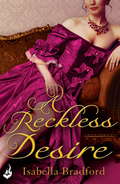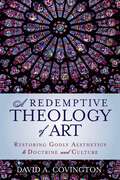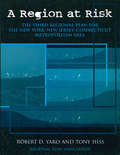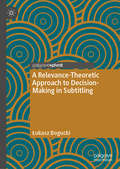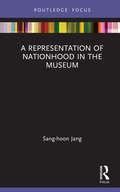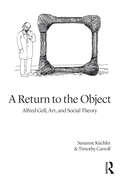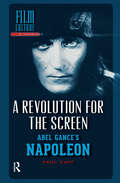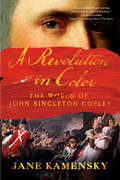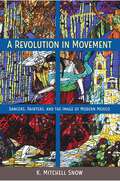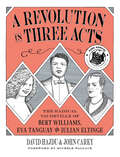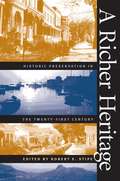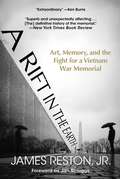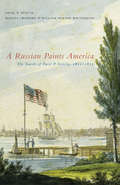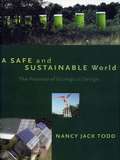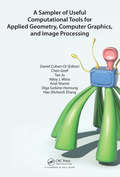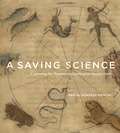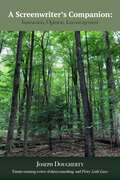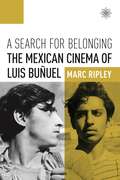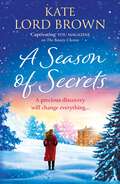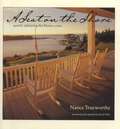- Table View
- List View
A Reckless Desire: Breconridge Brothers Book 3 (Breconridge Brothers)
by Isabella BradfordFor fans of Julia Quinn, Eloisa James and Sarah MacLean, comes Isabella Bradford's enthralling new trilogy of London's most scandalous rakes, the Breconridge Brothers, who are about to lose their hearts...Though charming and handsome, Lord Rivers Fitzroy, the youngest Breconridge brother, is more inclined to dusty books than brazen women. But when his father insists he marries, he vows to make the most of his last days as a bachelor.And what better way than in the company of a troupe of Italian dancers, where he's challenged to a wager he can't resist: turn the players' meek and mousy cousin into the first lady of the London stage.But he gets more than he bargained for with Lucia di Rossi. She has her own past to overcome and her own starlit aspirations. As the lines between performance and passion become blurred will finding the spotlight mean losing their hearts?Catch the rest of the dazzling series! Don't miss A Wicked Pursuit and A Sinful Decption. Before the Breconridge Brothers, came the Wylder sisters. Don't miss a moment of the romantic and captivating debut trilogy from Isabella Bradford: When You Wish Upon a Duke, When The Duchess Said Yes and When The Duke Found Love.
A Redemptive Theology of Art: Restoring Godly Aesthetics to Doctrine and Culture
by David A. CovingtonA Redemptive Theology of Art develops a biblical, systematic, and practical theology of aesthetics. It begins with the roots and ontology of aesthetics (vs. "art") and the architecture and narrative of affection and passion, their woes and their glory.Those who would search the Bible find little support for "art" as commonly conceived in the West. The language of aesthetics, applied to the maker’s intentions, the qualities of the work, and the responses of the audience, better addresses the questions of beauty, and better suits the discussion of human actions, beliefs, and culture than the language of art does. The Bible yields more consistent and helpful answers to questions about the broader category of aesthetics than it does to questions about art; leading in turn to better questions and a more practical and theological appreciation of human affections, beauty, and delight, and the many paths by which people, including Christians, pursue them.Using the categories and definitions from Scripture, Covington gives hope and help not only for those who labor in the arts, but for everyone who cares about the passions that motivate us. We were made for God's delight, and, though sin and bondage plague our passions, God can shape our fun, feelings, desires, affections and aversions. Feelings are neither objective nor subjective; they are redeemable. Borrowing key ideas from other Christian writers on the arts or aesthetics, Covington explores the connection between orthodox Protestant theology and a responsible, respectful treatment of arts, artists, and all aesthetic fields of human work and speech.
A Reference Manual for Data Privacy Laws and Cyber Frameworks (Cyber Shorts)
by Ravindra DasAs the world is becoming more digital and entwined together, the cybersecurity threat landscape has no doubt become a daunting one. For example, typical threat variants of the past, especially those of phishing, have now become much more sophisticated and covert in nature. A lot of this has been brought on by the proliferation of ransomware, which exploded during the COVID-19 pandemic. Now, there is another concern that is looming on the horizon: data privacy. Now, more than ever, consumers on a global basis want to know exactly what is happening to their personal identifiable information (PII) datasets. Examples of what they want to know about include the following: What kinds and types of information and data are being collected about them How those PII datasets are being stored, processed, and transacted with How their PII datasets are being used by third-party suppliers In response to these concerns and fears, as well as the cyber risks posed by these datasets, many nations around the world have set up rather extensive and very detailed data privacy laws. In their respective tenets and provisions, these pieces of legislation not only specify why and how businesses need to comply with them, but also outline the rights that are afforded to each and every consumer. In this book, we detail the tenets and provisions of three key data privacy laws: The GDPR The CCPA The CMMC We also provide a general framework at the end on how a business can comply with these various data privacy laws.The book begins with an in-depth overview of the importance of data and datasets, and how they are so relevant to the data privacy laws just mentioned.
A Region at Risk: The Third Regional Plan For The New York-New Jersey-Connecticut Metropolitan Area
by Tony Hiss Robert YaroRegional Plan Association, the nation's oldest regional planning organization, has worked since 1929 to improve the quality of life in the New York-New Jersey-Connecticut metropolitan area. The Association has crafted two long-term plans and successfully promoted their implementation through advocacy and coalition building.The Association's Third Regional Plan describes a series of key initiatives aimed at not only improving quality of life, but also at increasing economic competitiveness, encouraging more sustainable patterns of growth, and expanding opportunities and choice in employment, housing, and community.The Plan presents five major campaigns, each of which combines the goals of economic, equity, and environmental improvements. They are: Greensward -- to protect and restore large natural resource systems at the periphery of urbanized areas Centers -- to "recenter" regions that have experienced decades of sprawl growth Mobility -- to transform existing transit infrastructure to create a regional express rail network that would dramatically improve public transit, reduce highway congestion, and speed freight movement Workforce -- to provide the region's workforce with the skills and opportunities needed to participate in the economy of the future Governance -- to rationalize the activities of existing authorities, encourage service sharing among municipal governments, and encourage more effective state and regional land-use planning programs While focusing on the New York-New Jersey-Connecticut metropolitan area, the Plan's broad themes have universal applicability to regions throughout the industrialized world.
A Regulatory Framework for the Art Market?: Authenticity, Forgeries and the Role of Art Experts (Studies in Art, Heritage, Law and the Market #7)
by Anna BolzThis book addresses practical issues in connoisseurship and authentication, as well as the legal implications that arise when an artwork’s authenticity is challenged. In addition, the standards and processes of authentication are critically examined and the legal complications which can inhibit the expression of expert opinions are discussed. The notion of authenticity has always commanded the attention of art market participants and the general art-minded public alike. Coinciding with this, forgery is often considered to be the world’s most glamorous crime, packed with detective stories that are usually astonishing and often bizarre. The research includes findings by economists, sociologists, art historians, lawyers, academics and practitioners, all of which yield insights into the mechanics and peculiarities of the art business and explain why it works so differently from other markets. However, this book will be of interest not only to academics, but to everyone interested in questions of authenticity, forgery and connoisseurship. At the same time, one of its main aims is to advocate best practices in the art market and to stress the importance of cooperation among all disciplines with a stake in it. The results are intended to offer guidance to art market stakeholders, legal practitioners and art historians alike, while also promoting mutual understanding and cooperation.
A Relevance-Theoretic Approach to Decision-Making in Subtitling
by Łukasz BoguckiThis book aims to investigate the process of decision-making in subtitling of feature films and entertainment series. The author uses Relevance Theory (Sperber and Wilson,1986) to argue that the technical, linguistic and translational constraints at work in subtitling result in a curtailed target text, and illustrates this argument by invoking examples drawn from the English-Polish subtitles of films and television series available through the subscription service Netflix. After introducing the current state of research on audiovisual translation within and outside the framework of translation studies, he presents the core concepts underpinning Relevance Theory and explains how it can be used to construct a model of the process of subtitling. This book will be of interest to students and scholars working in the fields of translation studies, audiovisual translation studies, and communication studies.
A Representation of Nationhood in the Museum: The National Museum of Korea (Routledge Research on Museums and Heritage in Asia)
by Sang-hoon JangA Representation of Nationhood in the Museum examines how the National Museum of Korea, as a national repository of material culture and the state’s premier exhibition facility, has shaped and been shaped by Korean nationalism. Exploring the processes by which the museum has discovered and interpreted material culture, using concepts of ethnic nationalism in the historical and political contexts of South Korean society, the book analyses how this nationalist interpretation has regulated South Koreans’ understanding of their material culture. Issues considered include: cultural and political relations with China; Japanese colonial rule, cultural imperialism and its legacy; the division of Korea since 1945; the Korean War and nation building since liberation in 1945; and domestic political upheavals, including military coups in 1961 and in 1979. Demonstrating that authoritarian regimes’ emphasis on the promotion of national unity drove national museums to establish national identity through material culture, Jang argues that international political and diplomatic factors also affect the process of the formation of national identity in a specific political context. Concerning itself with issues such as the relationship between politics and identity, museums and authoritarian regimes, this book should be essential reading for academics, researchers and postgraduate students in museum studies, nationalism studies, Asian studies and history departments.
A Return to the Object: Alfred Gell, Art, and Social Theory
by Timothy Carroll Susanne KuechlerThis book draws on the work of anthropologist Alfred Gell to reinstate the importance of the object in art and society. Rather than presenting art as a passive recipient of the artist's intention and the audience's critique, the authors consider it in the social environment of its production and reception. A Return to the Object introduces the historical and theoretical framework out of which an anthropology of art has emerged, and examines the conditions under which it has renewed interest. It also explores what art 'does' as a social and cultural phenomenon, and how it can impact alternative ways of organising and managing knowledge. Making use of ethnography, museological practice, the intellectual history of the arts and sciences, material culture studies and intangible heritage, the authors present a case for the re-orientation of current conversations surrounding the anthropology of art and social theory. This text will be of key interest to students and scholars in the social and historical sciences, arts and humanities, and cognitive sciences.
A Revolution for the Screen: Abel Gance's Napoleon (Film Culture in Transition)
by Paul CuffAbel Gance's silent masterpiece, Napoleon, was given a limited run on its debut in 1927, but soon afterwards distributors in France and America, unwilling to deal with its nine-hour running time, subjected it to savage cuts - with devastating results for the movie and for film history. The struggle across ensuing decades to restore and reintegrate Gance's film has formed a backdrop to an array of formal, contextual, and ideological battles. In this book, Paul Cuff takes account of those battles and challenges received opinion on Gance's view of both his film and its subject.|Paul Cuff takes account of the struggle across decades to restore and reintegrate Gance's film Napoleon and challenges received opinion on this work.
A Revolution in Color: The World of John Singleton Copley
by Jane KamenskyThis bold new history recovers an unknown American Revolution as seen through the eyes of Boston-born painter John Singleton Copley. Boston in the 1740s: a bustling port at the edge of the British empire. A boy comes of age in a small wooden house along the Long Wharf, which juts into the harbor, as though reaching for London thousands of miles across the ocean. Sometime in his childhood, he learns to draw. That boy was John Singleton Copley, who became, by the 1760s, colonial America's premier painter. His brush captured the faces of his neighbors--ordinary men like Paul Revere, John Hancock, and Samuel Adams--who would become the revolutionary heroes of a new United States. Today, in museums across America, Copley's brilliant portraits evoke patriotic fervor and rebellious optimism. The artist, however, did not share his subjects' politics. Copley's nation was Britain; his capital, London. When rebellion sundered Britain's empire, both kin and calling determined the painter's allegiances. He sought the largest canvas for his talents and the safest home for his family. So, by the time the United States declared its independence, Copley and his kin were in London. He painted America's revolution from a far shore, as Britain's American War. An intimate portrait of the artist and his extraordinary times, Jane Kamensky's A Revolution in Color masterfully reveals the world of the American Revolution, a place in time riven by divided loyalties and tangled sympathies. Much like the world in which he lived, Copley's life and career were marked by spectacular rises and devastating falls. But though his ambivalence cost him dearly, the painter's achievements in both Britain and America made him a towering figure of both nations' artistic legacies.
A Revolution in Movement: Dancers, Painters, and the Image of Modern Mexico (Dancers, Painters, and the Image of Modern Mexico)
by K. Mitchell SnowHonorable Mention, Latin American Studies Association Mexico Section Best Book in the HumanitiesHow collaborations between dancers and painters shaped cultural identity in MexicoA Revolution in Movement is the first book to illuminate how collaborations between dancers and painters shaped Mexico’s postrevolutionary cultural identity. K. Mitchell Snow traces this relationship throughout nearly half a century of developments in Mexican dance—the emulation of Diaghilev’s Ballets Russes in the 1920s, the adoption of U.S.-style modern dance in the 1940s, and the creation of ballet-inspired folk dance in the 1960s.Snow describes the appearances in Mexico by Russian ballerina Anna Pavlova and Spanish concert dancer Tortóla Valencia, who helped motivate Mexico to express its own national identity through dance. He discusses the work of muralists and other visual artists in tandem with Mexico’s theatrical dance world, including Diego Rivera’s collaborations with ballet composer Carlos Chávez; Carlos Mérida’s leadership of the National School of Dance; José Clemente Orozco’s involvement in the creation of the Ballet de la Ciudad de México; and Miguel Covarrubias, who led the "golden age" of Mexican modern dance. Snow draws from a rich trove of historical newspaper accounts and other contemporary documents to show how these collaborations produced an image of modern Mexico that would prove popular both locally and internationally and continues to endure today.
A Revolution in Three Acts: The Radical Vaudeville of Bert Williams, Eva Tanguay, and Julian Eltinge
by David Hajdu John CareyBert Williams—a Black man forced to perform in blackface who challenged the stereotypes of minstrelsy. Eva Tanguay—an entertainer with the signature song “I Don’t Care” who flouted the rules of propriety to redefine womanhood for the modern age. Julian Eltinge—a female impersonator who entranced and unnerved audiences by embodying the feminine ideal Tanguay rejected. At the turn of the twentieth century, they became three of the most provocative and popular performers in vaudeville, the form in which American mass entertainment first took shape.A Revolution in Three Acts explores how these vaudeville stars defied the standards of their time to change how their audiences thought about what it meant to be American, to be Black, to be a woman or a man. The writer David Hajdu and the artist John Carey collaborate in this work of graphic nonfiction, crafting powerful portrayals of Williams, Tanguay, and Eltinge to show how they transformed American culture. Hand-drawn images give vivid visual form to the lives and work of the book’s subjects and their world.This book is at once a deft telling of three intricately entwined stories, a lush evocation of a performance milieu with unabashed entertainment value, and an eye-opening account of a key moment in American cultural history with striking parallels to present-day questions of race, gender, and sexual identity.
A Richer Heritage
by Robert E. StipeSurveying the past, present, and future of historic preservation in America, this book features fifteen essays by some of the most important voices in the field. A Richer Heritage will be an essential, thought-provoking guide for professionals as well as administrators, volunteers, and policy makers involved in preservation efforts.An introduction traces the evolution of historic preservation in America, highlighting the principal ideas and events that have shaped and continue to shape the movement. The book also describes the workings--legal, administrative, and fiscal--of the layered federal, state, and local government partnership put in place by Congress in 1966. Individual chapters explore the preservation of designed and vernacular landscapes, the relationship between historic preservation and the larger environmental and land-trust movements, the role of new private and nonprofit players, racial and ethnic interests in historic preservation, and the preservation of our intangible cultural values. A concluding chapter analyzes the present state of the historic preservation movement and suggests future directions for the field in the twenty-first century. Contributors include preservationists, local-government citizen activists, an architect, landscape architects, environmentalists, an archaeologist, a real-estate developer, historians, a Native American tribal leader, an ethnologist, and lawyers.
A Rift in the Earth: Art, Memory, and the Fight for a Vietnam War Memorial
by James Reston Jr.A Distinguished and Bestselling Historian and Army Veteran Revisits the Culture War that Raged around the Selection of Maya Lin's Design for the Vietnam Memorial A Rift in the Earth tells the remarkable story of the ferocious “art war” that raged between 1979 and 1984 over what kind of memorial should be built to honor the men and women who died in the Vietnam War. The story intertwines art, politics, historical memory, patriotism, racism, and a fascinating set of characters, from those who fought in the conflict and those who resisted it to politicians at the highest level. At its center are two enduring figures: Maya Lin, a young, Asian-American architecture student at Yale whose abstract design won the international competition but triggered a fierce backlash among powerful figures; and Frederick Hart, an innovative sculptor of humble origins on the cusp of stardom. James Reston, Jr., a veteran who lost a close friend in the war and has written incisively about the conflict's bitter aftermath, explores how the debate reignited passions around Vietnam long after the war’s end and raised questions about how best to honor those who fought and sacrificed in an ill-advised war. Richly illustrated with photographs from the era and design entries from the memorial competition, A Rift in the Earth is timed to appear alongside Ken Burns's eagerly anticipated PBS documentary, The Vietnam War. “The memorial appears as a rift in the earth, a long polished black stone wall, emerging from and receding into the earth."—Maya Lin "I see the wall as a kind of ocean, a sea of sacrifice. . . . I place these figures upon the shore of that sea." —Frederick Hart
A Russian Paints America
by Marina Swoboda William Whisenhunt Pavel P. Svin'InA Russian Paints America presents the first complete English translation of Svin'in's fascinating memoir. Thirty-one original watercolours complement his provocative views on topics such as slavery, religion, politics, and the fine arts. Introductory essays by Marina Swoboda and William Whisenhunt examine Russian-American relations, consider Svin'in's life and particular role in Russian history, and set his work in the context of the genre of picturesque travel - Svin'in clearly did not set out to produce a scholarly account of the United States but a work of literature, at a time when Russian literary language was in its earliest stages of development.
A Russian Paints America: The Travels of Pavel P. Svin'in, 1811-1813
by Marina Swoboda William Whisenhunt Pavel P. Svin'inA Russian Paints America presents the first complete English translation of Svin'in's fascinating memoir. Thirty-one original watercolours complement his provocative views on topics such as slavery, religion, politics, and the fine arts. Introductory essays by Marina Swoboda and William Whisenhunt examine Russian-American relations, consider Svin'in's life and particular role in Russian history, and set his work in the context of the genre of picturesque travel - Svin'in clearly did not set out to produce a scholarly account of the United States but a work of literature, at a time when Russian literary language was in its earliest stages of development.
A Safe and Sustainable World: The Promise Of Ecological Design
by Nancy Jack ToddIn the late sixties, as the world awoke to a need for Earth Day, a pioneering group founded a small non-profit research and education organization they called the New Alchemy Institute. Their aim was to explore the ways a safer and more sustainable world could be created. In the ensuing years, along with scientists, agriculturists, and a host of enthusiastic amateurs and friends, they set out to discover new ways that basic human needs--in the form of food, shelter, and energy--could be met. A Safe and Sustainable World is the story of that journey, as it was and as it continues to be.The dynamics and the resilience of the living world were the Institute's model and inspiration for their research. Central to their efforts then and now is, along with science, a spiritual quest for a more harmonious human role in our planet's future. The results of this work have now entered mainstream science through the emerging discipline of ecological design.Nancy Jack Todd relates a fascinating journey from lofty ideals through the hard realities encountered in learning how to actually grow food, harness the energy of the sun and wind, and design green architecture. She also introduces us to some of the heroes and mentors who played a vital role in those efforts, from Buckminster Fuller to Margaret Mead.Successfully proving through the Institute's designs and investigations that basic land sustainability is achievable, John Todd and the author founded a second non-profit research group, Ocean Arks International. A Safe and Sustainable World demonstrates what has, can, and must be done to integrate human ingenuity and four billion years of evolutionary intelligence into healthy, decentralized, local dreams.
A Sampler of Useful Computational Tools for Applied Geometry, Computer Graphics, and Image Processing
by Niloy J. Mitra Daniel Cohen-Or Chen Greif Tao Ju Olga Sorkine-Hornung Ariel Shamir Hao Richard ZhangA Sampler of Useful Computational Tools for Applied Geometry, Computer Graphics, and Image Processing shows how to use a collection of mathematical techniques to solve important problems in applied mathematics and computer science areas. The book discusses fundamental tools in analytical geometry and linear algebra. It covers a wide range of topics
A Saving Science: Capturing the Heavens in Carolingian Manuscripts
by Eric M. Ramírez-WeaverIn A Saving Science, Eric Ramírez-Weaver explores the significance of early medieval astronomy in the Frankish empire, using as his lens an astronomical masterpiece, the deluxe manuscript of the Handbook of 809, painted in roughly 830 for Bishop Drogo of Metz, one of Charlemagne’s sons. Created in an age in which careful study of the heavens served a liturgical purpose—to reckon Christian feast days and seasons accurately and thus reflect a “heavenly” order—the diagrams of celestial bodies in the Handbook of 809 are extraordinary signifiers of the intersection of Christian art and classical astronomy.Ramírez-Weaver shows how, by studying this lavishly painted and carefully executed manuscript, we gain a unique understanding of early medieval astronomy and its cultural significance. In a time when the Frankish church sought to renew society through education, the Handbook of 809 presented a model in which study aided the spiritual reform of the cleric’s soul, and, by extension, enabled the spiritual care of his community. An exciting new interpretation of Frankish painting, A Saving Science shows that constellations in books such as Drogo’s were not simple copies for posterity’s sake, but functional tools in the service of the rejuvenation of a creative Carolingian culture.
A Saving Science: Capturing the Heavens in Carolingian Manuscripts
by Eric M. Ramírez-WeaverIn A Saving Science, Eric Ramírez-Weaver explores the significance of early medieval astronomy in the Frankish empire, using as his lens an astronomical masterpiece, the deluxe manuscript of the Handbook of 809, painted in roughly 830 for Bishop Drogo of Metz, one of Charlemagne’s sons. Created in an age in which careful study of the heavens served a liturgical purpose—to reckon Christian feast days and seasons accurately and thus reflect a “heavenly” order—the diagrams of celestial bodies in the Handbook of 809 are extraordinary signifiers of the intersection of Christian art and classical astronomy.Ramírez-Weaver shows how, by studying this lavishly painted and carefully executed manuscript, we gain a unique understanding of early medieval astronomy and its cultural significance. In a time when the Frankish church sought to renew society through education, the Handbook of 809 presented a model in which study aided the spiritual reform of the cleric’s soul, and, by extension, enabled the spiritual care of his community. An exciting new interpretation of Frankish painting, A Saving Science shows that constellations in books such as Drogo’s were not simple copies for posterity’s sake, but functional tools in the service of the rejuvenation of a creative Carolingian culture.
A Screenwriter's Companion: Instruction, Opinion, Encouragement
by Joseph DoughertyEveryone wants to write for television, and now there's a book that teaches you how to do it by an author who has not only done it himself, but has won multiple awards in the process. &“I was a writer before I knew what a writer was.&” -Joseph DoughertyJoseph Dougherty has been a successful playwright and television writer, producer, and director for more than thirty years. He&’s written for breakthrough series that have changed the way we look at television drama, from thirtysomething to Pretty Little Liars, winning everything from Emmys to Teen Choice Awards along the way. In A Screenwriter&’s Companion,Dougherty offers insights and advice both practical and nonpractical to writers and would-be writers. Dougherty&’s voice comes off the page with anecdotes about the writing process, hard-learned tips for survival in &“the business,&” and reflections on the influences that led him to a successful career. Honestly, entertainingly, without cynicism, he gives readers permission to embrace the writer they want to be, so they can experience the rewards and satisfactions of writing. Beyond an insider&’s take on story and structure, dialogue, action and outlining, A Screenwriter&’s Companionis as much mentor as it is manual. With every insider observation about how to keep a potential producer reading till the last page of a script, there&’s encouragement to explore your thoughts and memories, things a writer needs to embrace in order to become more than &“a pro.&” In short, to see writing not as merely a career, but as a way to greater self-understanding. With a Foreword by Scott Ryan (thirtysomething at thirty: an oral history). This book was selected by Foreword Magazine as one of the Best Gift Items of Fall 2022.
A Search for Belonging: The Mexican Cinema of Luis Buñuel
by Marc RipleyAs one of the foremost Spanish directors of all time, Luis Buñuel’s filmography has been the subject of innumerable studies. Despite the fact that the twenty films he made in Mexico between 1947 and 1965 represent the most prolific stage of his career as a filmmaker, these have remained relatively neglected in writing on Buñuel and his work. This book focuses on nine of the director’s films made in Mexico in order to show that a concerted focus on space, an important aspect of the films’ narratives that is often intimated by scholars, yet rarely developed, can unlock new philosophical meaning in this rich body of work.Although in recent years Buñuel’s Mexican films have begun to enjoy a greater presence in criticism on the director, they are often segregated according to their perceived critical value, effectively creating two substrands of work: the independent movies and the studio potboilers. The interdisciplinary approach of this book unites the two, focusing on films such as Los olvidados, Nazarín, and El ángel exterminador alongside La Mort en ce jardin, The Young One, and Simón del desierto, among others. In doing so, it avoids the tropes most often associated with Buñuel’s cinema—surrealism, Catholicism, the derision of the bourgeoisie—and the approach most often invoked in analysis of these themes: psychoanalysis. Instead, this book takes inspiration from the fields of human geography, anthropology, and philosophy, applying these to film-focused readings of Buñuel’s Mexican cinema to argue that ultimately these films depict an overriding sense of placelessness, overtly or subliminally enacting a search for belonging that forces the viewer to question what it means to be in place.
A Season of Secrets
by Kate Lord Brown'The perfect read for a cosy winter's evening beside a crackling log fire' Sussex LifeDiamonds are forever.And hold a thousand secrets... When Grace Manners moves to a little cottage on the Wittering Manor estate, she hopes it will be the perfect new beginning after her life was torn apart seven months ago. Ever since her husband disappeared, along with most of their money, Grace has struggled to make ends meet - but now, working for the eccentric Fraser Stratton, she has her own space to make her delicate jewellery once again.Yet as Grace begins to uncover the story behind a beautiful diamond brooch, she becomes drawn into a mysterious family secret that threatens to destroy what little she has left...Praise for Kate Lord Brown:'Absolutely exquisite' Marian Keyes'A wonderful, escapist, nostalgic read' RED'Sweepingly romantic' Katherine Webb'Captivating' YOU'A story of love and adventure, of loss and pain, and heroism' DAILY MAIL----------------------------------------------------Previously published as The Christmas We Met
A Season of Secrets
by Kate Lord Brown'The perfect read for a cosy winter's evening beside a crackling log fire' Sussex LifeDiamonds are forever.And hold a thousand secrets... When Grace Manners moves to a little cottage on the Wittering Manor estate, she hopes it will be the perfect new beginning after her life was torn apart seven months ago. Ever since her husband disappeared, along with most of their money, Grace has struggled to make ends meet - but now, working for the eccentric Fraser Stratton, she has her own space to make her delicate jewellery once again.Yet as Grace begins to uncover the story behind a beautiful diamond brooch, she becomes drawn into a mysterious family secret that threatens to destroy what little she has left...Praise for Kate Lord Brown:'Absolutely exquisite' Marian Keyes'A wonderful, escapist, nostalgic read' RED'Sweepingly romantic' Katherine Webb'Captivating' YOU'A story of love and adventure, of loss and pain, and heroism' DAILY MAIL----------------------------------------------------Previously published as The Christmas We Met
A Seat on the Shore
by Nance TrueworthyPhotographer Nance Trueworthy takes the reader off the beaten track to places along the Maine coast where you can leave your harried life behind and sit and admire the extraordinary beauty of this part of the country. Several of the photographs include various kinds of seats, inviting the reader to set a spell while taking in views such as a secluded beach, a weathered wharf with colorful skiffs, or a grand old Victorian inn.
